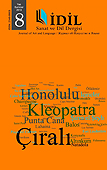DİLBİLİMSEL KAVRAMSALCILIKTA ANTİ - GÖRSEL DENEYİM VE ANTİ - ESTETİK HAZ: JOSEPH KOSUTH
ANTI-VISUAL EXPERIENCE AND ANTI-AESTHETIC PLEASURE IN LINGUISTIC CONCEPTUALISM: JOSEPH KOSUTH
Author(s): Erhun ŞengülSubject(s): Fine Arts / Performing Arts, Psychology, Aesthetics, Sociology
Published by: Sanat ve Dil Araştırmaları Enstitüsü
Keywords: Conceptual; Linguistic; Avant-garde; Sociology; Psychology; Aesthetic;
Summary/Abstract: 1960s is a period that art was reshaped especially in Europe and in America and that is fed by its countercultural discourses. Duchamp’s conception of “art as idea” has pointed art’s anti-objective and idea dimension by coinciding with fields such as politics, philosophy, sociology and psychology. Conceptual artists such as Mel Bochner, Joseph Kosuth, Robert Barry, Lawrance Weiner, Terry Atkinson, played important role in foundation of the group “Art and Language” in England in 1968. As describing the role and importance of the language factor to idealize conceptualism in art, Mel Bochner points out that the conceptual artwork must have an exact linguistic equivalence and must be constantly experienceable. In this process that the objectivity in art disappears, Joseph Kosuth, one of the linguistic conceptualists, has entirely excluded the visual experience and the state of aesthetic pleasure in the work of art by a further expression “without language there is no art”. The article deals with the annihilation process of objectivity and aesthetic pleasure in artwork by linguistic conceptualism, and it is illustrated by Joseph Kosuth’s works, who is one of the most important representatives of this process.
Journal: İdil Sanat ve Dil Dergisi
- Issue Year: 2/2013
- Issue No: 08
- Page Range: 1-13
- Page Count: 13
- Language: Turkish

